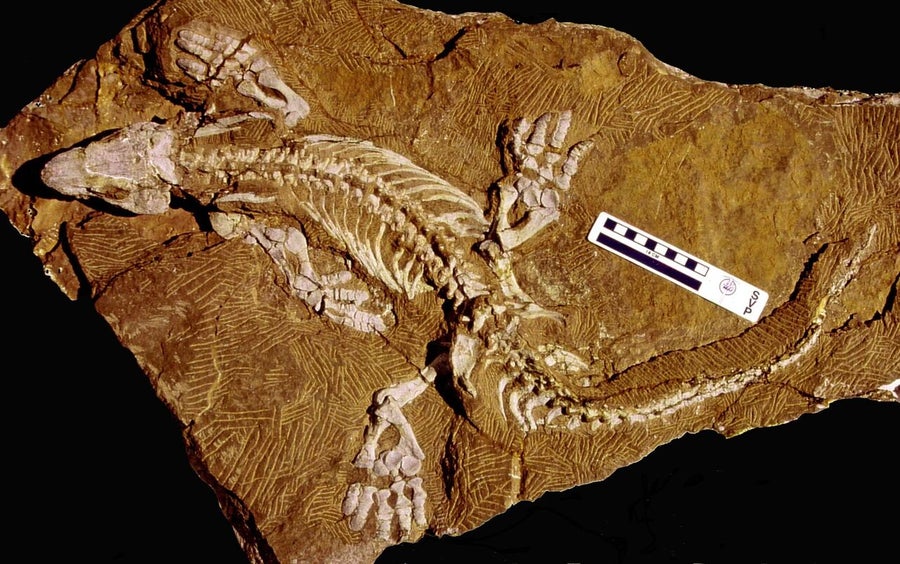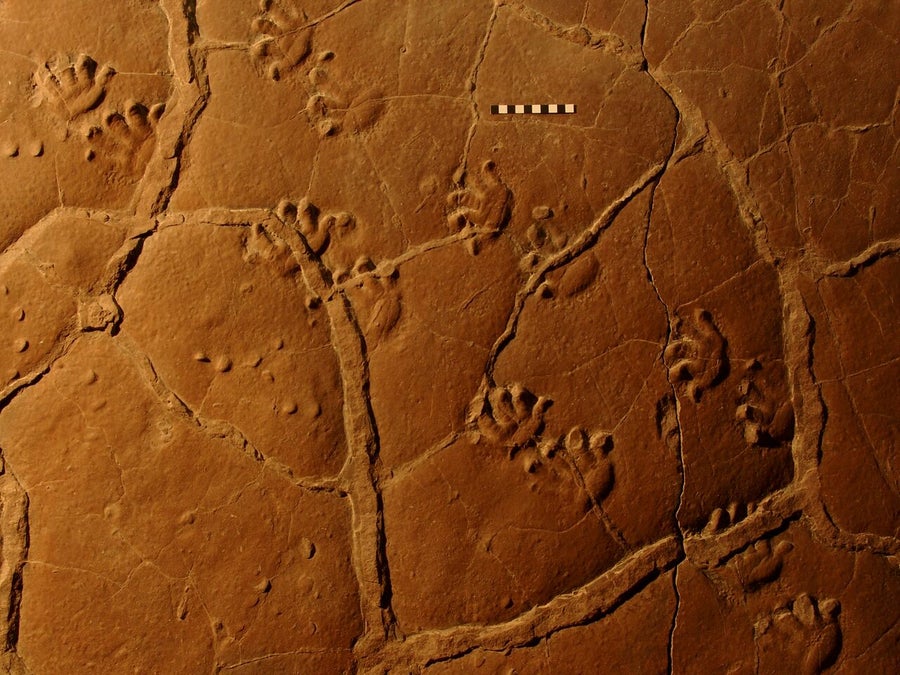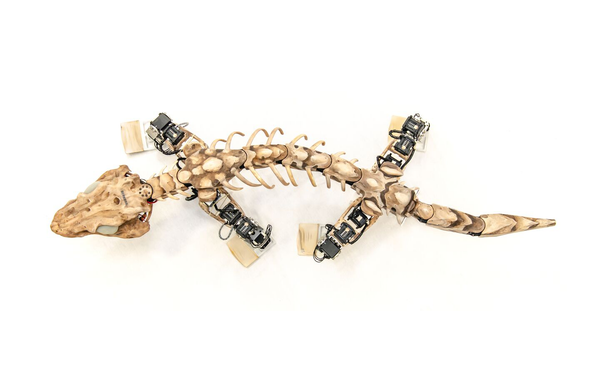Some 290 million years ago a four-legged, plant-eating creature the size of large dog roamed what is now central Germany. It did not carry itself like most other tetrapods known from that time, belly low to the ground and limbs splayed out to the sides; instead it walked taller, tucking its limbs under its body for a more erect posture. That is the portrait emerging from a new multidisciplinary study that has reconstructed the locomotion of this long-extinct animal, called Orobates pabsti—in part by developing a robot version of the beast to test the physics of various gaits. And it adds to a growing body of evidence that the textbook account of when and how four-limbed animals conquered terra firma needs revision.
Tetrapods got their start in the water about 400 million years ago in the Devonian period, evolving from fish with fleshy fins. Their eventual colonization of land was a seminal event in the evolution of backboned, or vertebrate, animals. In the conventional view of this transition early terrestrial tetrapods were largely limited to moving in the low-slung, undulating manner of salamanders and lizards. Only after around 251 million years ago, at the end of the Permian period, did they start to evolve different styles of locomotion that helped them enter new ecological niches available to them on land. Or so the story went.

Orobates is known from spectacularly well-preserved fossils from the Bromacker quarry in Germany. Credit: Thomas Martens Museum der Natur Gotha
On supporting science journalism
If you're enjoying this article, consider supporting our award-winning journalism by subscribing. By purchasing a subscription you are helping to ensure the future of impactful stories about the discoveries and ideas shaping our world today.
Scientists have considered the development of a more erect, balanced and energy-efficient way of moving to be a key innovation during this transition, one that set the stage for a major diversification of species in the lineage leading to amniotes—the group that includes reptiles, birds and mammals. The trick has been figuring out from the fossil record which animals were the first to comport themselves in this way. To that end, the new study of Orobates, published Thursday in Nature, has marshaled a massive amount of data from fossil and living animals and analyzed it with an array of cutting-edge tools to show how this ancient tetrapod (a close relative of the lineage leading to modern amniotes) walked. The results are helping rewrite the time line of tetrapod locomotor evolution.
Orobates is an ideal candidate for such a study. For one thing, it is represented by complete skeletons—a rarity for Permian fossils. For another, it is associated with a trackway of fossil footprints that nicely match the fossil foot anatomy. Previous research on the skeleton and trackway hinted Orobates might have walked with its legs positioned closer to the midline of the body rather than in full sprawl. To test that possibility and others, John Nyakatura of Humboldt University of Berlin and his colleagues developed a computer model of the animal, based on the anatomy evident in the fossil skeleton and on biomechanical data from living tetrapods that exhibit varying degrees of sprawling. The researchers used this model to determine the fossil animal’s range of motion. They also developed a computer model that allowed them to calculate the physical forces acting on Orobates during different kinds of locomotion. And they built a robot version of Orobates, dubbed OroBOT, which they used to validate the results of the latter simulation under real-world conditions. The fossil footprints provided a key constraint on the simulations: the gaits needed to match the tracks to be considered plausible.
The team tested hundreds of gaits with their models to figure out which one Orobates is likely to have employed. In the end, the walk they deemed most probable for the ancient tetrapod was one that resembled the movement of the caiman, a species of crocodilian—indicating this more advanced, erect form of locomotion evolved roughly 40 million years earlier than previously surmised.
Nyakatura and his colleagues “have gotten us as close as we can get without a time machine” to knowing how Orobates walked, says paleontologist Stuart Sumida of California State University, San Bernardino, an expert on Permian tetrapods who was not involved in the new study. Sumida—who discovered Orobates in 2000—notes it is not the only animal to hint at locomotor diversity among early terrestrial tetrapods. He and his colleagues have shown another animal from the same fossil locality in Germany, Eudibamus cursoris, could run on two legs. “The range of locomotor capabilities of animals leading to [modern amniotes and their relatives] is much greater than we thought,” Sumida says. And if this experimentation began as far back as 290 million years ago, that could shift researchers’ understanding of the rise of the amniotes. “It might have been more gradual,” he adds.

Trackways left by Orobates provided an important constraint in the simulations used to identify the most plausible gaits for the creature. Credit: Sebastian Voigt Urweltmuseum Geoskop Thallichtenberg
According to study co-author John Hutchinson, an expert on evolutionary biomechanics at the Royal Veterinary College in the U.K., this new work has yielded the most detailed, accurate reconstruction to date of how an extinct creature moved around, with the possible exception of locomotor reconstructions done for some early human species. The researchers have set up a Web site that allows visitors to play around with the filters that constrain their simulations. They suggest their approach can be used to figure how other fossil species moved, including those relevant to other major transitions in vertebrate evolution—such as the evolution of upright walking or active flight.
But would one need comparably well-preserved fossils, which are awfully hard to come by, to apply this method to another species? “That’s the $10,000,000 question,” Hutchinson says. “I think it is a matter of degree—one could apply the method to other fossils with somewhat less confidence if they had less marvelous preservation. Or one could be creative and find ways to improve the method: add new data on extant (or even extra fossil) species to help ‘bracket’ what the extinct animal might have done or not done, or include data on muscles or something else to help constrain the simulations and robot further.”
